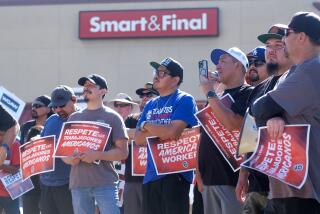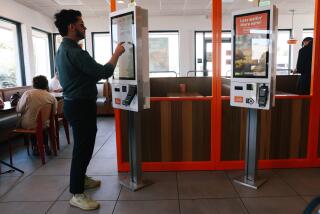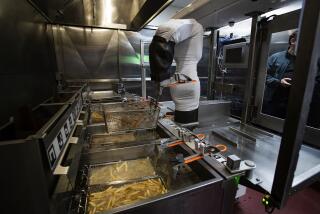The Cutting Edge: Computing / Technology / Innovation : CASE STUDY: How technology changed a business : At Smart & Final, Some Savvy Computer Buys Ended a Crisis
Smart & Final’s inventory managers were at the end of their rope. Shipments were disappearing into the company’s vast warehouse in Vernon. Space was running out. Employees couldn’t put their hands on what customers needed fast enough.
The problem was that Smart & Final’s powerful mainframe computer system was too rigid to help keep timely track of the 150,000 items shipped every day. The company was considering building a new warehouse--or moving out of Los Angeles.
As it turned out, Smart & Final--the oldest “cash and carry” retail chain in the country--had more room than it realized. Now, without moving, it can keep track of every roll of toilet paper and box of rice that comes into the place.
The company did it by using a computer system that keeps track of the stock in “real time.” This is important because, with the warehouse operating at more than 95% capacity (80% is ideal), having unaccounted-for storage space is wasteful and extremely costly.
For help, Smart & Final turned to Beverly Hills-based Motek Information Systems, which specializes in developing computer systems for businesses.
The situation was critical. The Vernon warehouse, containing more than 6,000 products at 50,000 different pallet locations, serves 70% of Smart & Final’s 137 stores. The warehouse receives about 3,000 pallets of goods every day, and there are fewer than 1,000 pallet slots open each morning.
“We were supposed to be out of this facility 18 months ago,” recalled Carlos Angulo, Smart & Final’s director of distribution.
Motek saw that Smart & Final had been tracking warehouse inventory with IBM’s mainframe-based Chain Store System. Although this was fine for warehouse purchasing and accounting, it could not be updated more often than every 12 hours. This meant Smart & Final was losing valuable time while shelf space in the 550,000-square-foot warehouse was empty.
Unfilled space in a warehouse is akin to a ship anchored in port or an airliner at the gate--it loses money for the owner. Forklift operators would zoom a quarter of a mile down the cavernous aisles of the warehouse, only to discover that the item wasn’t there--someone had retrieved it earlier in the day, but the computer had not yet recorded the movement. Under orders to move 16 to 18 pallets an hour, the forklift operators were forced to waste valuable time.
“Most warehouses today still work on paper and pencil,” said David Price, Motek’s technology director. “Unbelievably, 85% of warehouses still are not automated.”
Motek found a way to improve Smart & Final’s mainframe system instead of scrapping it. The solution was to use a small computer “server” to link the mainframe system with mobile radio-frequency computers mounted on the forklifts.
The forklift operators now use a scanner to read bar code labels on the pallets; the information is relayed wirelessly (and instantly) to the server. Thus the system is immediately told of every change in the inventory.
The result of this real-time inventory tracking is that Smart & Final sharply boosted the efficiency of warehouse employees and carved out additional space in the facility. The forklift drivers’ productivity has improved 16%, and warehouse capacity is up 10% to 15%, the company says.
“It puts us a full day ahead as far as how soon we can use locations in the warehouse,” Angulo said.
At the end of the day, even the most efficient real-time inventory tracking system could not keep up with Smart & Final’s rapid growth. The company is building an additional warehouse, in Stockton, to serve its Northern California stores. Meanwhile, the Vernon warehouse will remain open.
More to Read
Inside the business of entertainment
The Wide Shot brings you news, analysis and insights on everything from streaming wars to production — and what it all means for the future.
You may occasionally receive promotional content from the Los Angeles Times.










